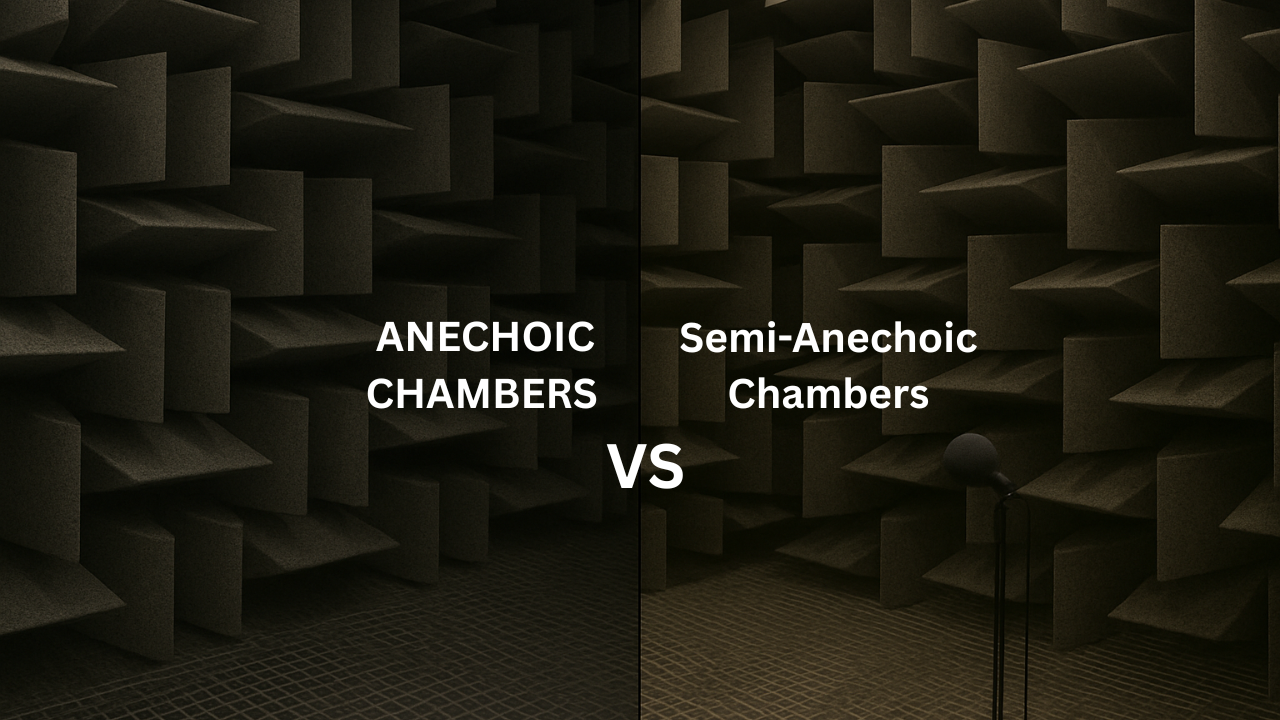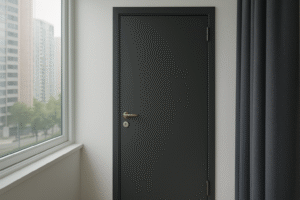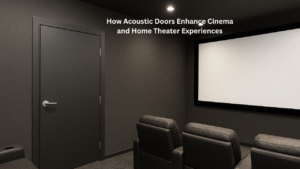Anechoic vs Semi-Anechoic Chambers: Differences in Design, Testing Accuracy, and Real-World Use Cases
In today’s rapidly advancing technological world, accuracy in sound and electromagnetic testing is essential. Whether you are developing next-generation electronics, evaluating the noise performance of vehicles, or analyzing acoustic behavior in controlled environments, the testing conditions must be precise and interference-free. This is where specially designed testing environments like Anechoic Chambers and Semi-Anechoic Chambers come into play.
While both chambers are built to control sound reflections and external noise, their design and purpose differ significantly. Understanding these differences helps engineers, researchers, and manufacturers choose the correct facility for their testing requirements. Selecting the right type of chamber not only improves accuracy but also saves valuable time and investment in repeated testing.
In this detailed guide, we will explore what these chambers are, how they work, their specific applications, key differences, and how you can choose the right one for your project.
What Is an Anechoic Chamber?
An Anechoic Chamber is a highly specialized room designed to completely absorb sound or electromagnetic wave reflections. The word “anechoic” means without echo, indicating that any sound or electromagnetic wave produced inside the chamber is not reflected by the walls, ceiling, or floor.
How It Works
The interior of an anechoic chamber is covered with sound-absorbing materials such as polyurethane foam wedges or fiberglass structures. These materials prevent the sound waves from bouncing back, creating an environment that simulates open space. The wedges are strategically placed to trap and dissipate sound energy into heat, ensuring that no echo returns to the source.
In electromagnetic testing, similar principles apply, but the walls are coated with RF absorbers instead of acoustic foam. These absorbers minimize radio frequency reflections, allowing for precise electromagnetic interference (EMI) and electromagnetic compatibility (EMC) testing.
Applications of Anechoic Chambers
Anechoic chambers are widely used across multiple industries due to their unmatched precision. Some of their major applications include:
- Audio equipment testing for speakers, microphones, and headphones.
- Aerospace and defense research for radar and antenna testing.
- Electromagnetic compatibility (EMC) testing for electronic devices and circuit boards.
- Telecommunication product development, ensuring minimal signal interference.
- University and research labs studying sound propagation, noise reduction, and material acoustics.
Key Advantages
- Provides the most accurate measurement conditions by eliminating all reflections.
- Ensures compliance with international testing standards like ISO 3745 and ANSI S12.55.
- Enables precise calibration of microphones and sensors.
- Eliminates external environmental noise, improving the repeatability of results.
An anechoic chamber is therefore the gold standard for high-precision acoustic and electromagnetic testing, where even the smallest reflection can affect data accuracy.
What Is a Semi-Anechoic Chamber?
A Semi-Anechoic Chamber shares the same foundational concept as an anechoic chamber but with one critical difference: its floor is reflective rather than absorbent. This design allows sound to reflect off the floor, simulating realistic conditions similar to those experienced in open-field environments.
How It Works
In a semi-anechoic chamber, the walls and ceiling are covered with the same sound-absorbing materials used in a full anechoic chamber, but the floor remains solid, usually made of concrete or metal. This reflective surface enables engineers to test how sound behaves when it interacts with real-world surfaces.
For example, when testing a car engine, the sound that bounces off the road surface is essential for accurate measurements. The semi-anechoic design replicates this reflection, giving engineers realistic data without external noise interference.
Applications of Semi-Anechoic Chambers
Semi-anechoic chambers are extremely versatile and are commonly used in industries that require large-scale or ground-reflective testing.
- Automotive testing for measuring engine noise, tire noise, and exhaust sound levels.
- Industrial machinery testing to evaluate equipment sound power levels.
- Home appliance testing, such as washing machines, refrigerators, and HVAC systems.
- Vibration and noise control studies for mechanical and structural systems.
- Electromagnetic testing for large equipment where ground reflection must be considered.
Key Advantages
- Simulates real-world ground reflection conditions.
- Suitable for large-scale testing, such as vehicles and machinery.
- Cost-effective compared to full anechoic chambers.
- Easier to construct and maintain.
Semi-anechoic chambers provide an excellent balance between realism and precision, making them ideal for industrial applications.
Key Differences Between Anechoic and Semi-Anechoic Chambers
Although both types of chambers are designed for precision testing, they differ in structure, purpose, and testing accuracy. The table below summarizes their primary differences:
| Feature | Anechoic Chamber | Semi-Anechoic Chamber |
| Surface Treatment | All surfaces (walls, ceiling, floor) are absorbent | Walls and ceiling are absorbent, the floor is reflective |
| Acoustic Environment | Free-field condition with no reflections | Simulates real-world conditions with floor reflections |
| Testing Accuracy | Highest possible accuracy | Slightly less accurate but more realistic |
| Applications | Acoustic and electromagnetic precision testing | Automotive, industrial, and large-scale testing |
| Cost | Higher due to full absorption treatment | Moderate cost |
| Installation Size | Typically smaller | Usually larger to accommodate equipment or vehicles |
| Testing Type | Laboratory and research-based | Real-world simulation and compliance testing |
Summary of Differences
An anechoic chamber is used when absolute precision and reflection-free conditions are required, such as in acoustic calibration or electromagnetic measurement. In contrast, a semi-anechoic chamber is ideal when testing needs to replicate how sound or electromagnetic waves behave in a practical, real-world environment.
How to Choose the Right Chamber for Your Testing Needs
Choosing between an anechoic and semi-anechoic chamber depends on multiple factors, including the type of test, budget, and the accuracy required. Below are some important considerations to guide your decision.
1. Testing Objective
If your goal is to measure sound or electromagnetic waves with maximum accuracy, such as microphone calibration, antenna pattern measurement, or EMC certification, an anechoic chamber is the right choice.
If you need to understand how your product behaves in conditions similar to everyday environments, such as road or floor reflections, a semi-anechoic chamber is more appropriate.
2. Type of Product or Equipment
For small-scale products like smartphones, sensors, or speakers, a full anechoic chamber provides more control and precision. For large-scale products like vehicles, engines, or household appliances, a semi-anechoic chamber offers the right combination of space and realism.
3. Budget Considerations
Since anechoic chambers require more complex absorption treatment and construction, they generally have a higher cost. Semi-anechoic chambers, with fewer absorption materials and easier installation, provide a cost-effective alternative without sacrificing too much accuracy.
4. Testing Standards and Compliance
Both chambers can be designed to meet international standards, but the choice depends on the specific regulatory requirements. Standards such as ISO 3744, ISO 3745, and CISPR 16 specify the type of chamber needed for different tests. Consulting with an expert manufacturer ensures that your chamber meets the necessary certifications.
Benefits of Using High-Quality Anechoic and Semi-Anechoic Chambers
Investing in a professionally designed testing chamber brings numerous benefits to research and product development.
Improved Accuracy and Reliability
High-quality chambers provide consistent test conditions, reducing measurement uncertainty and improving product validation results.
Enhanced Compliance
Properly designed chambers meet global standards for acoustic and electromagnetic testing, helping organizations avoid costly recertifications.
Cost and Time Savings
With controlled testing environments, there is less need for outdoor or field tests, saving time, labor, and logistics expenses.
Increased Product Quality
Better testing environments lead to quieter, more efficient, and better-performing products, enhancing brand reputation and customer satisfaction.
Research Advancement
These chambers are essential for universities and R&D facilities conducting advanced acoustic, vibration, and EM wave studies.
Ecotone Systems – Your Partner for Advanced Acoustic Solutions
Ecotone Systems is a trusted name in the field of acoustic engineering, specializing in the design and construction of Anechoic and Semi-Anechoic Chambers that meet international standards. Our expert team provides end-to-end solutions, from concept design and acoustic modeling to installation and performance testing.
Our Core Solutions Include:
- Anechoic Chambers for precision sound and electromagnetic testing.
- Semi-Anechoic Chambers for automotive and machinery applications.
- Building Acoustics Solutions for controlling noise and vibration in structures.
- Acoustic Louvers for effective airflow management with sound control.
- Noise Barriers for industrial and infrastructure applications.
At Ecotone Systems, every project is customized to the client’s needs, ensuring long-term reliability, safety, and superior acoustic performance.
If you are seeking world-class acoustic solutions in India or abroad, contact Ecotone Systems today to discuss your project and receive expert guidance tailored to your specific application.
Conclusion
Both Anechoic Chambers and Semi-Anechoic Chambers are essential tools for accurate acoustic and electromagnetic testing. While anechoic chambers offer the highest level of precision in completely reflection-free environments, semi-anechoic chambers provide more practical testing conditions that simulate real-world behavior.
Choosing between the two depends on your application, accuracy requirements, and budget. Partnering with an experienced manufacturer like Ecotone Systems ensures that your testing environment is designed and built to exact specifications, delivering superior performance, compliance, and long-term reliability.
With the right acoustic environment, you can achieve more accurate results, faster product development, and better quality assurance for your innovations.
Frequently Asked Questions (FAQs)
Q1. What is the main difference between anechoic and semi-anechoic chambers?
The main difference is that an anechoic chamber absorbs sound on all surfaces, while a semi-anechoic chamber has a reflective floor that allows realistic ground reflection during testing.
Q2. Which chamber is best for automotive testing?
A semi-anechoic chamber is ideal for automotive testing because it replicates real-world road reflections, making it perfect for measuring engine and tire noise.
Q3. Can a semi-anechoic chamber simulate outdoor conditions?
Yes, semi-anechoic chambers are specifically designed to simulate open-field conditions indoors by allowing controlled floor reflections while isolating external noise.
Q4. How much does it cost to build an anechoic chamber?
The cost depends on several factors, including size, design complexity, and the type of absorption materials used. Generally, anechoic chambers are more expensive than semi-anechoic ones because they require full surface treatment.
Q5. Who provides anechoic chambers in India?
Ecotone Systems is one of India’s leading providers of custom-designed anechoic and semi-anechoic chambers, offering turnkey acoustic and noise control solutions for industries such as aerospace, automotive, electronics, and research.





